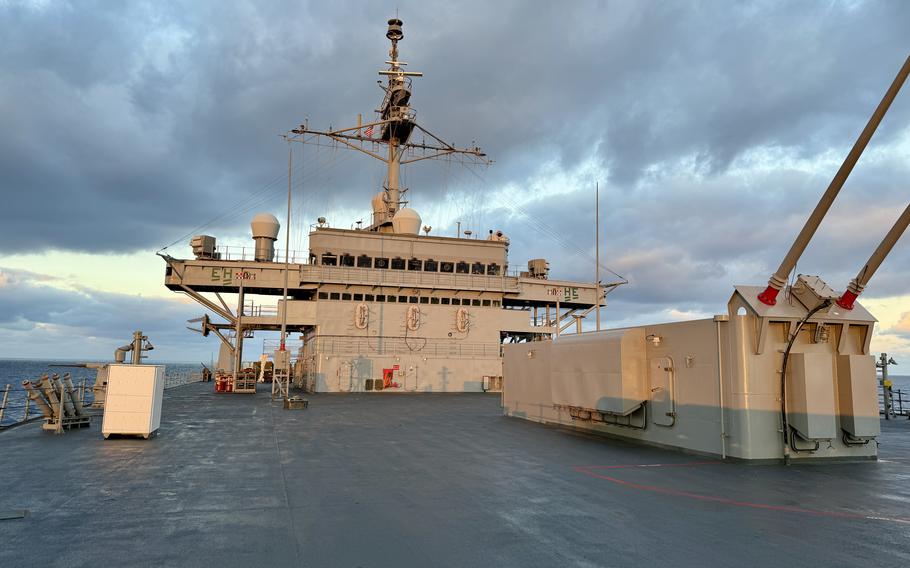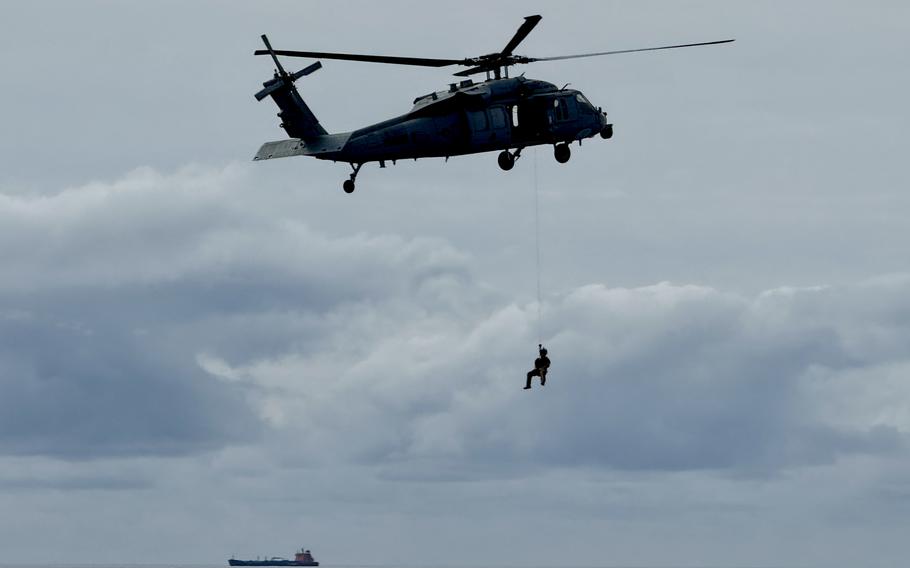
U.S. 6th Fleet flagship USS Mount Whitney is on the Navy’s shortlist for decommissioning. Officials aboard the command-and-control ship say no other vessel or building in the service offers the same maritime operations center capabilities. (Alison Bath/Stars and Stripes)
ABOARD THE USS MOUNT WHITNEY — The Navy wants to mothball the only ship in the fleet that allows a U.S. commander to simultaneously lead U.S. and NATO forces in Europe and Africa, a move critics say would weaken combat flexibility and American influence abroad.
USS Mount Whitney, flagship of the Naples, Italy-based 6th Fleet, provides capabilities that no other Navy facility or platform — including aircraft carriers, amphibious groups or even sister ship USS Blue Ridge — can match, sailors aboard the vessel said.
Simply put, “we are a floating Pentagon,” said Lt. Cmdr. Jonathan DeSimone, a communications information systems officer assigned to the ship.
The one-of-a-kind status lies in its dual, secure command centers for U.S. and NATO forces, allowing sailors to operate jointly without compromising sensitive information, DeSimone said.
Recent communication upgrades give Vice Adm. Jeffrey Anderson, who leads both 6th Fleet and Naval Striking and Support Forces NATO, the flexibility to direct operations from sea without traveling ashore to command centers in Italy and Portugal.
“In a crisis or conflict, I have to be able to have the ability to simultaneously do it from one location,” Anderson said. That capability isn’t possible in Naples or Lisbon, he said.
Yet in its 2023 budget, the Navy said it wanted to decommission Mount Whitney next year to save some $179 million annually. The ship’s functions could be handled ashore, the service said at the time without specifying how.
That date was extended to 2027, a Navy spokesperson said Thursday.
However, sailors aboard Mount Whitney said they believe the ship actually will be in service for a decade or more in a series of incremental extensions.
In recent years, the Navy has submitted budgets calling for the retirement of a sizable number of older vessels to make way for a more advanced, lethal fleet, a divest-to-invest strategy that often draws the scrutiny of Congress.
In 2023, the Navy sought to retire 16 ships early, but Congress approved only six.
The plan to decommission Mount Whitney has raised alarm among advocates and analysts, who say it defies common sense. It limits options during crises, undercuts diplomacy and strains operational readiness, they say.
Sebastian Bruns, a maritime expert at the Institute for Security Policy at Kiel University, said Mount Whitney can project naval power and diplomacy better in some instances than an armed destroyer or cruiser.
The window of opportunity to use the ship in that capacity appears to be closing “if one assumes that Mount Whitney will be decommissioned, will not be replaced, and if one assumes … the moving away of the United States from Europe is going to continue,” Bruns said.
Despite its strategic use, Mount Whitney is ineligible for congressional funding for critical needs because it’s on the decommissioning list. The ship, which entered service in January 1971, needs upgrades to its defensive systems to ensure it remains mission-ready, shipboard officials said.
In comparison, the Navy has extended the service life of Blue Ridge, its oldest operational warship, until 2039.
The ship “is not going to get the real services and help she needs to really stay modern and to be able to keep pace with the threats of the times,” said Lt. Cmdr. Kenyon Cowart, a combat systems maintenance officer.
Even before Mount Whitney’s communications overhaul, analysts and retired Navy officers argued that the ship’s maritime operations center and versatility couldn’t be matched.
A shore-based replacement facility would eliminate the ability to move into international waters if another country, potentially Italy, objected to military decisions within its borders.
The ship traveled about 12 miles offshore in 2011 to support multinational forces during Operation Odyssey Dawn in Libya, the precursor to the fall of Libyan dictator Moammar Gadhafi. It deployed to the Black Sea during the 2008 Russia-Georgia war and was there again in 2021 amid tensions over Ukraine.
And in the fall of 2023, Mount Whitney was stationed in the eastern Mediterranean Sea for about six weeks as the U.S. worked to keep conflict in the Middle East from spreading after Hamas’ attack on Israel.
“We can go to where the fight is or where we’re going to be used most effectively to provide (a commander) the most situational awareness,” said Capt. Colin Price, commanding officer of Mount Whitney.
The vessel’s crew of about 300 Navy sailors and civilian mariners can support at least 200 more personnel with workspace, accommodations and high-end technology.
That flexibility allows Mount Whitney to take on many different roles in the 6th Fleet area of responsibility, which stretches from the Arctic to Antarctica, Price said.
Blue Ridge, which functions as the maritime operations center for 7th Fleet both ashore and at sea, doesn’t have the same ability, officials said.
“There is no other ship in the world that can do that like we can,” Price said.

Helicopter Sea Combat Squadron 28, Detachment 1 practices live hoist training in the Atlantic Ocean on May 9, 2025. The squadron is attached to USS Mount Whitney, which was in Africa earlier this month as part of the Obangame Express military exercise. (Alison Bath/Stars and Stripes)
Little more than a day after hosting African military officials and dignitaries in Praia, Cabo Verde, earlier this month, Mount Whitney was scheduled to make a port call in the West African country of Mauritania.
But the visit in Nouakchott didn’t go as planned.
There weren’t enough tugboats available to tow the 634-foot-long vessel into port, and sea conditions made it unsafe to ferry visitors to the ship. Anchoring wasn’t a possibility.
Instead, Price and a delegation flew ashore by helicopter for a visit. Mauritania’s chief of naval operations and other leaders later flew out to the ship.
On-the-fly adaptation is routine, officials said, as Mount Whitney sustains military relationships in countries with limited port infrastructure.
The vessel’s frequent role in hosting foreign VIPs has earned it a reputation as a sort of “party ship,” complete with good food, music and fun.
But that perception underestimates the importance of naval diplomacy in regions of the world where the U.S. is challenged to build and sustain relationships, officials said.
The military has long been part of a multipronged strategy to gain U.S. influence in Africa, a role likely to grow with the shuttering of most U.S. Agency for International Development functions, looming State Department cuts and freezes on foreign aid.
The ship’s presence in Mauritania helped foster the U.S. security relationship with the country, which sits at the nexus of the Maghreb and sub-Saharan Africa. The region is impacted by violent extremist groups, notably in neighboring Mali, according to the State Department.
The U.S. also wants to grow its economic ties by encouraging American businesses to invest in the region, said John Ice, charge d’affaires at the U.S. Embassy in Mauritania. He said cooperative military and economic efforts each contribute to security goals.
Since January, Mount Whitney has made port calls in Cyprus, Tunisia, Libya and Cabo Verde. Its visits to the Libyan cities of Tripoli and Benghazi last month, the first by a Navy ship to the country in 56 years, sent a clear message that the U.S. remains engaged in North Africa, analysts said.
The ship can throw a party for dignitaries as well as offer space for high-level discussions around the world while staying focused on operations. And that makes Mount Whitney indispensable, said Ensign Joshua Coatney, an electronics material officer.
“It just all comes together,” Coatney said.